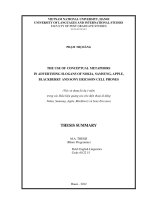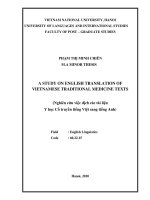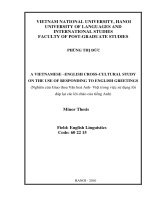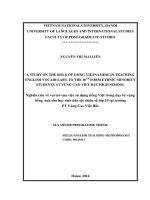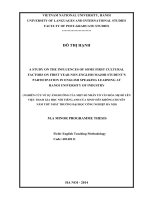A STUDY ON LINGUISTIC FEATURES OF LAPTOP BRANDS ADVERTISING SLOGANS = NGHIÊN cứu về đặc điểm NGÔN NGỮ TRONG KHẨU HIỆU QUẢNG cáo CHO các HÃNG LAPTOP
Bạn đang xem bản rút gọn của tài liệu. Xem và tải ngay bản đầy đủ của tài liệu tại đây (759.78 KB, 58 trang )
VIETNAM NATIONAL UNIVERSITY, HANOI
UNIVERSITY OF LANGUAGES AND INTERNATIONAL STUDIES
FACULTY OF LINGUISTICS & CULTURES OF
ENGLISH-SPEAKING COUNTRIES
GRADUATION PAPER
A STUDY ON LINGUISTIC FEATURES OF
LAPTOP BRANDS ADVERTISING SLOGANS
Supervisor: Vũ Thị Thu Thủy, MA.
Student: Đinh Thu Hương
Year of enrolment: QH2017.F1.E22
HÀ NỘI – 2021
ĐẠI HỌC QUỐC GIA HÀ NỘI
TRƯỜNG ĐẠI HỌC NGOẠI NGỮ
KHOA NGƠN NGỮ VÀ VĂN HỐ CÁC NƯỚC NĨI TIẾNG ANH
KHỐ LUẬN TỐT NGHIỆP
NGHIÊN CỨU VỀ ĐẶC ĐIỂM NGÔN NGỮ
TRONG KHẨU HIỆU QUẢNG CÁO
CHO CÁC HÃNG LAPTOP
Giáo viên hướng dẫn: Th.S Vũ Thị Thu Thuỷ
Sinh viên: Đinh Thu Hương
Khoá: QH2017.F1.E22
HÀ NỘI – 2021
ACCEPTANCE
I hereby state that I: Đinh Thu Hương, class QH2017.F.1.E22, being a candidate for
the degree of Bachelor (English Language) accept the requirements of the University
relating to the retention and use of Bachelor’s Graduation Paper deposited in the
library.
In terms of these conditions, I agree that the origin of my paper deposited in the library
should be accessible for the purposes of study and research, in accordance with the
normal conditions established by the librarian for the care, loan or reproduction of the
paper.
Signature
Date: May 4th 2021
ACKNOWLEDGEMENTS
First and foremost, I would like to express the deepest gratitude to our supervisor,
Ms. Vũ Thị Thu Thủy, M.A., lecturer of Division of English Linguistics for her great
guidance and assistance. All of her advice and suggestions are of invaluable
contribution during our research process. This consultation which is an indispensable
factor results in a fruitful accomplishment of the research.
Moreover, I would love to give thanks to my teachers and friends for their
motivational support and encouragement on the research. Without their stimulation
and belief, I cannot be optimistic enough to complete this thesis and achieve my final
goals.
Last but not least. I am thankful to my family who give me unconditional
sacrifices and caring environment so that I could be confident enough on the path I
choose.
i
ABSTRACT
In the context of technology burst and globalization, the launch of advertising
campaign to promote products becomes more and more ubiquitous; therefore, it is
effortless to find an advertisements on newspapers, billboards or commercial on social
media. In advertising, depicting the characteristics of the product is not enough.
Brands expect the messages behind the product to be conveyed in a concise,
memorable and catchy way so as to appeal the attraction of consumers.
Thus, this study was conducted with the aim to discussing the adoption of
syntactic features and metaphors from semantic approach in the advertising slogans of
six most popular laptop brands in Vietnam, namely: Asus, Acer, Apple, Dell, Lenovo
and HP (Hewlett-Packard). The researcher analysed the use of syntactic patterns in
slogans then utilised the framework of Lakoff and Johnson (1980) - the derivation of
conceptual metaphors to classify types of metaphors in 16 slogans from Internet
sources to gain the understanding in both meaning and structure aspects. To complete
this procedure, the researcher mainly used descriptive approach, qualitative and
quantitative method. According, the results show that verb phrases appeared frequently
to describe the effectiveness of the products, the in the second question, ontological
metaphors was used more frequently than other types in slogans.
ii
TABLE OF CONTENTS
ACKNOWLEDGEMENTS………………………………………………………………i
ABSTRACT……………………………………………………………………………….ii
TABLE OF CONTENTS………………………………………………………………..iii
PART 1: INTRODUCTION……………………………………………………………...1
1.1. Statement of research problem & Rationale for the study…………………………1
1.2. Research objectives and Research questions……………………………………….2
1.3. Scope of research…………………………………………………………………...3
1.4. Significance of the study……………………………………………………………3
1.5. Method of the study………………………………………………………………...4
1.6. Organization………………………………………………………………………..4
PART 2: DEVELOPMENT………………………………………………………………6
CHAPTER 1: LITERATURE REVIEW………………………………………………..6
1.1. Definition of key terms……………………………………………………………..6
1.1.1. Advertising slogans…………………………………………………………….…6
1.1.1.1. Definition of advertising………………………………………………..6
1.1.1.2. Definition of slogans…………………………………………………,,.7
1.1.2. Syntactic features of slogans…………………………………………………….8
1.1.2.1, Phrasal structures……………………………………………………..8
1.1.2.2. Simple sentences………………………………………………………11
1.1.3. Metaphors……………………………………………………………………….13
1.1.3.1. Definition of metaphors…………………………………………………..13
iii
1.1.3.2. Conceptual metaphors……………………………………………………15
1.1.3.3. Classification of conceptual metaphors………………………………….15
1.1.3.3.1. Structural metaphors……………………………………………15
1.1.3.3.2. Ontological metaphors………………………………………….16
1.1.3.3.3. Orientational metaphors………………………………………..16
1.2. Previous studies of metaphors in advertising……………………………………..17
CHAPTER 2: RESEARCH METHODOLOGY……………………………………....19
2.1 Research design…………………………………………………………………….19
2.2. Subjects of the study………………………………………………………………20
2.3. Research samples………………………………………………………………….20
2.3.1. Data source……………………………………………………………...20
2.3.2. Features of research samples……………………………………………20
2.4. Data collection procedures………………………………………………………...21
2.5. Data analysis procedures…………………………………………………………..21
CHAPTER 3: RESULTS AND FINDINGS……………………………………………23
3.1. The syntactic patterns applied in each type of metaphors …………………..23
3.2. The frequency of advertising slogans in each metaphor type..………………31
CHAPTER 4: CONCLUSION AND DISCUSSION…………………………………..37
4.1. Conclusion………………………………………………………………………...37
4.2. Limitations and suggestions for further research…………………………………38
REFERENCES…………………………………………………………………………..40
APPENDICES……………………………………………………………………………43
APPENDIX 1: List of selected slogans………………………………………………..43
iv
APPENDIX 2:
Table A1: Target domain, source domain and metaphor concepts of conceptual
metaphors in laptop slogans.………………………………………………………….44
APPENDIX 3:
Table A2: Types of syntactic patterns in laptop slogans………………………………47
v
LIST OF FIGURES
Figure
Page
Figure 1.1: The translation of metaphor by Newmark (1988)
14
Figure 3.1: Types of phrasal structure in advertising slogans
24
Figure 3.1: Distribution of two simple sentence types in advertising
29
slogans
Figure 3.3: Proportion of three sub-types of conceptual metaphors
31
used in each laptop brand.
LIST OF TABLES
Figure
Page
Table A1: Target domain, source domain and metaphor concepts of
44
conceptual metaphors in laptop slogans
Table A2: Types of syntactic patterns in laptop slogans
vi
47
PART 1: INTRODUCTION
This chapter presents brief information about the paper. Six main points are
provided namely (1) statement of problem and rational for the study, (2) objectives
and research questions, (3) method of the study, (4) scope of the study, (5) significance
of the study and (6) study organization.
1.1. Statement of research problem and rationale for the study
It is undeniable that in the world of information exploration, there are thousands
of products introduced to consumers everyday. Therefore, it is mandatory for brands to
launch an effective marketing campaign in order to intrigue the attention of the public
through mass media so that they could reach the products, including beverages, food,
medicines, technological items and so on. From that vision, manufacturers have
always considered advertising as one of the most vital tools to spread their goods and
messages by having creative ideas. One major way to express the inspiration of a
product or a company is through slogans - a powerful element to persuade consumers
to purchase goods.
There are a number of linguistic devices exploited in a slogan which contains
several features: short, understandable, competitive, memorable, consistent; thus, those
slogans could increase the preference of consumers and make them outstanding
compared to their competitors in the market. To have an impressive slogan,
copywriters should include various linguistic patterns and there are two approaches
that the researcher chooses to study thoroughly, namely syntactic approach with the
use of clauses and sentences and semantic approach with the most used aspects here metaphors which could generate beliefs, improve the images of products and services
(Nguyen, 2010).
1
There are many studies which have discussed the use of metaphors in the
advertising field. For instance, Cherono (2018) discussed the use of metaphor in food
and drink advertising slogans or Pham (2012) provided a clear view of the way
conceptual metaphor is exploited in cell phones slogans. By contrast, papers
concerning syntactic features of advertising slogans are limited. The sentence structure
is an essential part that is hard to omit since it is a means to convey the messages from
advertisers, without it, the readers are unable to understand the products. Only a few
studies investigated this field, however, the research objects is quite different from
which is aimed in this paper, such as “A descriptive analysis of linguistic features of
advertising language used in English slogans for food and drink products” (Bui, 2012)
or “Syntactic patterns in advertising slogans” (Karsita & Apriana, 2012).
On the other hand, there is little research on linguistic appliances in marketing
strategies of laptop slogans. even though laptop plays a crucial role in the work of
students, officers, particularly in the context of the 4.0 industrial revolution and Covid19 pandemic, which is required more technology applied in the way people learn and
work. In this way, brands need to have a careful choice of language to persuade the
demanding customers in such a variety and competitive market. Thus, a study in this
aspect can be a valuable reference source to advertisers or company if they want to
deliver the message of an advertisement more effectively.
All the conditions above have offered the researchers a chance to conduct a
study on “linguistic features of advertising slogans of laptop brands'' with a basis of
Lakoff and Johnson’s framework (1980) and theory from Brinton (2000).
1.2. Research objectives and research questions
This study is conducted with three main purposes. First, it focuses on
investigating the application of linguistic features including syntactic features and
conceptual metaphors in 16 advertising slogans from the 6 most popular laptop
2
brands. In addition, the classification of metaphors is also elucidated based on the
scheme of Lakoff and Johnson (1980). Second, the study aims to figure out the
structures of each slogan to draw out the most significant syntactic features with the
theory contributed by Brinton (2000).
In order to illuminate the purposes above, the research would be designed to
solve two following questions:
1. What are the syntactic features of computer slogans?
2. What kinds of conceptual metaphors are most frequently chosen in computer
advertising slogans?
1.3. Research methods
The researcher combines descriptive, qualitative and quantitative methods to
have a thorough look into the topic. The first approach provides thorough and detailed
descriptions of chosen laptop brands slogans. Regarding quantitative method, there
could be the most general picture over the selected cases by applying statistical
analysis of data. Hence, the researcher can identify the frequency before calculating
the proportion of metaphors and their sub-types as well as different syntactic patterns
in the samples. On the other hand, qualitative method is employed with the goal to find
the basic and core features of each focus representative to gain deeper insight into each
specific sample.
1.4. Scope of research
Due to the constraint of time and limited corpus of a B.A. thesis, this study only
concentrates on six laptop brands’ slogans which are popular in Vietnam, including
Acer, Lenovo, Apple, Dell, Asus and HP (Hewlett-Packard). The selection of slogans
are considered based on the timeline of each brand, from 2003 up to now to guarantee
3
the scope of this study; thus, there are 16 slogans as figured out in the Appendix 1.
They are taken from sloganlist.com source on the Internet. Nonetheless, the number of
slogans, to some extent, is not large enough to have the most extensive result; they are
just chosen as typical samples for the most intensive research.
Moreover, in this study, the researcher deals with English slogans of laptop
brands in two linguistics aspects: syntactic features including clauses as well as
sentences and semantic features which focus on conceptual metaphors. In addition,
there are various theories of many scholars and linguists mentioned in the paper to
build the theoretical background. The two most prominent framework applied in this
paper are and from Brinton (2000) so as to investigate the syntactic patterns of phrase
and sentences used in advertising slogans and from Lakoff and Johnson (1980) to
analyse conceptual metaphors and classify them into different groups.
1.5. Significance of the Study
This study is expected to give insights into both the theoretical and practical
aspects of linguistic features in advertising slogans of laptop brands. First, a number of
typical linguistic features applied in English laptop slogans would be determined, and
the researcher supposed that the study would be useful for those who are interested in
English for specific purposes (ESP) as well as advertisers in Vietnam who hope to
promote products effectively in Vietnamese market.
1.6. Structure of the study
The research paper is conducted with 5 chapters:
Chapter 1: Introduction: This part provides the statement of the problem,
rationale, aims and objectives, significance, scope, method, and the organization of the
research.
4
Chapter 2: Literature review: presents the definition of the key terms and the
theoretical framework of the study.
Chapter 3: Methodology: gives information about the research approach,
research sample, data collection procedures, and data analysis methods of the research.
Chapter 4: Result and findings: In this section, the author would examine the
frequency of syntactic patterns and discuss significant characteristics of language in
slogans. Afterwards, the analysis of metaphors used in advertising slogans of laptop
brands from cognitive viewpoint is implemented and the trend of using types of
metaphors is also presented.
Chapter 5: Conclusion and discussion: This part summarizes the main points
discussed in this study. It also mentions the limitations of the study and includes
recommendations and suggestions for further studies.
5
PART II: DEVELOPMENT
CHAPTER 1: LITERATURE REVIEW
In this chapter, the researcher provides a theoretical foundation of the study, in
which the definitions of key terms and sub-related issues together with review of
studies related to advertising, slogans, syntactic patterns and conceptual metaphors,
are presented.
1.1. Definition of key terms
1.1.1. Advertising slogans
1.1.1.1. Definition of advertising
These days, advertisements are the key element to launch products utilized by
companies. There is no surprise that numerous large enterprises in the world become
famous and influential in the field that they hold; and spent billions on advertising to
keep their position in the eyes of customers. According to Wells (1989),
“advertisement is a paid non-personal communication from an identified sponsor using
mass media to persuade or influence an audience”. (cited in Karsita & Apriana, 2012).
Advertising becomes an integral part of our society, however, it does not concentrate
on individuals yet a specific group of people. It is a form of mass communication and
powerful tool to bring the flow of information of products to the buyers; it not only has
great impacts on different domains in our lives but also influences the way people act
or believe (Bui, 2011).
In addition, there is another suggestion from Goddard (1997) that “advertising
is not just about the commercial promotion of branded products, but can also
encompass the idea of texts whose intention is to enhance the image of an individual,
group or organization.”
Advertising has a lot of functions and there are reasons for marketers to
promote an advertising campaign stated by Bui (2011): “announcing a new product or
service”, “expanding the market”, “announcing a modification or a price change”,
“challenging competition”, “recruiting of staff and attracting investors”. With those
6
functions, it must be a challenge for copywriters to create effective advertisements
from new ideas; and language plays a critical role in the process of conceiving a
tempting and impressive content - what consumers benefit from the products. To deal
with that, copywriters need to carefully exploit the effectiveness of slogans and add the
linguistic devices into it.
1.1.1.2. Definition of slogans
As stated in a study, slogan is “backbone of the whole campaign, helping the
other party to memorize the product being advertised” (Pelclov, 2010, cited in Pham,
2012). Slogan is a short, memorable and catchy motto or phrase used in commercials,
which is used to deliver the message of the brand or the products. Its goal is to
persuade the public or the target group to create the desire to access the product and
make them memorize the message, which comes to the mind of consumers when they
think about the products.
In “The Language of Advertising - Written Texts”, Goddard (1997) figured out
that slogan is “a phrase designed to be memorable, attaching to a product or service
during a particular advertising campaign.” Its goal is to persuade the public or the
target group to create the desire to access the product and make them memorize the
message, which comes to the mind of consumers when they think about the products,
Moreover, a slogan must be a witty statement with a good sentence structure,
first to have the consumers understand it, then to make it disparate and competitive
from other companies. Let take those icon slogans of famous brands in the world as
examples:
"Just Do It" - Nike.
“Life’s good” - LG
"Think Different" - Apple.
“It’s finger lickin’ good” - KFC
7
There are various features of a slogan, yet it has to guarantee those criteria:
short, concise, precise, repeatable, memorable and effective (Nguyen, 2010). To be
specific, the slogan is required to convey the message within a few words and the less
words, the easier to remember and less difficult to recall afterwards. In addition, the
information of the products must be precise and optimally deliver the inspiration that
the manufacturers hope to obtain.
1.1.2. Syntactic features of slogans
In terms of syntax, Miller (2000) (cited in Do, 2009) stated that it is the
relationships between linguistics forms (words, phrases, clauses and sentences) in
which the small unit builds larger units and creates a sequence “syntax has to do with
how words are put together to build phrases, with how phrases are put together to build
clauses or bigger phrases, and with how clauses are put together to build sentences”.
To deal with the topic of advertising, Sari (2000) (cited in Karsita and Apriana, 2012)
emphasized that in advertisement copy, it acquired syntactic patterns as basic elements.
In this study, the main features of syntactic structure in English advertising
slogans are investigated in the level of phrase and sentence, to be specific, five phrasal
structures and simple sentences would be taken into consideration. To make this
choice of patterns, the research focuses on the characteristics of advertising slogans
mentioned above: the slogan is required to convey the message within a few words and
the less words, the easier to remember and less difficult to recall afterwards.
1.1.2.1. Phrasal structures
According to Miller (2002), the term “phrase” is applied only to sequences of
more than one word. There are five types of there are five types of phrases, they are:
noun phrase, verb phrase adjective phrase, adverb phrase, and prepositional phrase.
8
According to Brinton (2000), in the noun phrase, the noun is a compulsory
element and serves the role as a head while other parts, such as determiner (Det),
adjective/ adjective phrase or prepositional phrase, which follow the noun are optional
while Quirk & Greenbaum (1973) claimed that noun phrases were a noun or a pronoun
in the center and optional pre-modification and post-modification to add the meaning
to the head noun; moreover, in a clause or sentence, they could play the roles of
subject, object, complement or adverbial.
For instance, in the slogan of Lenovo “New World. New Thinking.”, “new” is
an adjective functioning as pre-modification and the head noun is “world”/”thinking”.
The preliminary structure for the noun phrase can be illustrated as the following:
The next phrasal structure is verb phrase which is a phrase headed by a verb,
established from a verb or the join of lexical verb (obligatory) and auxiliary verbs
(optional) (Miller & Jim, 2000). In addition, Carnie (2006, cited in Karsita and
Apriana, 2012) stated that a verb phrase can have adverbs, nouns, and also
prepositional phrases as the modifiers. For example, “Invented for life” (Good
Housekeeping, 2011) is identified as a verb phrase with a verb as the head.
It could be the same way to define two other phrasal structures which are
adjective phrase (adjective as the head) and adverb phrase (adverb as the head). In
general, adjective and adverb phrases appear inside noun phrases (Brinton, 2000,
p.169) and become the modifier for them to give information of characteristics of the
9
core noun. The expansion of the example “the very fiercely barking dog” might be the
following:
In prepositional phrases, it typically includes a preposition followed by a noun
phrase, a V-ing or Wh-clause. (Quirk & Greenbaum, 1973). This statement was also
agreed by Brinton (2000) when he claimed that the “P is the head of the PP, but unlike
the other categories we have examined, the P cannot stand alone in the PP. It must be
followed by an NP, what is traditionally known as an object of the preposition (OP).”
A slogan from Dell will be illustrated by the tree structure based on the theory
of Brinton (2000).
“Dell. Purely You.”
10
The phrase from Dell has the adverb “purely” as a head, followed by the
pronoun “you” as a modifier. Normally, the adverb phrase is viewed only as a modifier
of the verb or adjective
1.1.2.2. Simple sentences
A simple sentence consists of only one independent clause with two basic
constituents that are subject and verb, and it expresses a complete thought. In A
University Grammar Of English of Quirk and Greenbaum (2000), the authors pointed
out that a sentence consists of five elements, namely SUBJECT (S), VERB (V),
COMPLEMENT (C), OBJECT (O) AND ADVERBIAL (A). Normally, when
concentrating on compulsory elements, we could classify simple sentences into seven
clause types (Quirk & Greenbaum, 1973), comprising SV, SVC, SVA, SVO, SVOO,
SVOC AND SVOA. Here is an analyzed example from the slogan “We make the tools.
You make them do” of Lenovo:
SVO
SVOC
S
Vtrans
Od
We
make
S
Vcomplex trans
Oi
Co
You
make
them
do
the tools
On the other hand, Brinton (2000) did not mention the clear definition of simple
sentences yet provided the theory related to the formalisms of phrase structures as
stated above, consisting of noun phrase, verb phrase, adjective phrase, adverb phrase
and prepositional phrase. All the elements could be considered important parts of a
sentence in general and simple sentence in particular. Also with the slogan from
Lenovo, the researcher would present it through the following tree diagram:
11
In advertising, the use of simple sentences would provide a more impressive
influence on consumers’ perception rather than using compound or complex sentences.
This is due to the fact that a slogan must be short, memorable and catchy, therefore,
simple sentences would play a better role. According to the theory of Brinton (2000)
and Quirk and Greenbaum (2000), simple sentences may be divided into four major
types: declarative, imperative, interrogative and exclamatory sentences. In this study,
due to the narrowed scope and analysing process, one two syntactic classes namely
declarative and imperative sentences are included.
1.1.2.2.1. Declaratives
Declaratives are sentences in which “the subject is always present and generally
precedes the verb” (Quirk & Greenbaum, 2000). The functions of this sentence types
are making a statement, offering an explanation, conveying the message or providing a
fact. Here are several examples of declarative sentences:
- I choose to take my own path. I choose Dell. (Dell)
- We value your time (Ceturion Bank)
12
1.1.2.2.2. Imperatives
As Brinton (2000) stated, imperative sentences would have no subject and the
base of them would be a verb. This statement also shares the same idea in the theory of
(Quirk & Greenbaum, 2000). The subject in here is elliptical yet still understandable
based on the context contributing the meaning to let the listener know which the
subject is referred to. The function of an imperative sentence, normally, is to give a
command or instruction to the listeners so that they take actions. For example:
- Pass the salt!
- Take me to your leader!
- Don’t smoke in the restaurant!
1.1.3. Metaphors
1.1.3.1. Definition of metaphor
Metaphor is one of the linguistic devices utilized in every single aspect of life,
such as conversations, literature, advertising and so on; being obvious about that fact,
Lakoff and Johnson (1980, p.3) stated that “metaphor is pervasive in everyday life, not
just in language but in thought and action.” Accordingly, metaphor is not only applied
in a certain form of language but exists everywhere and plays a vital part in daily life.
From the cognitive perspective which is based on the theory of Lakoff and Johnson
(1980), metaphor is understood as a target domain utilized to explain the source
domain.
On the other hand, Newmark (1988, p.104) figured out that metaphor is a
figurative expression with three functions, namely the transferred sense of a physical
word; the personification of an abstraction and the application of a word or collocation
without literal meaning to imply one thing by another. From those definitions, it is
obvious that in metaphor, there are two terms having the relation with each other
through their resemblances.
13
Normally, metaphor includes three components: image (picture evoked by the
metaphor), object (what described by metaphor) and sense (the literal meaning of
metaphor); the relationship among them in a metaphorical expression are illustrated by
the figure below (Newmark, 1988, p.105).
Figure 1.1: The translation of metaphor by Newmark (1988)
As we can see from figure 1, metaphor is not just the way to familiarize the
unknown object or something abstract, but it conjures up the imagination of readers or
listeners, as a result, metaphor brings us cognitive and aesthetic purposes.
Besides, Knowles and Moon (2006) defined metaphor as “the use of language
to refer to something other than what it was originally applied to, or what it ‘literally’
means, in order to suggest some resemblance or make a connection between the two
things.” In this definition, the authors emphasized that metaphor is using one thing to
refer to another different thing, however, between two objects, there are several
similarities in the thought of the creator.
There are different ways to classify metaphor into sub-types, depending on the
various approaches of hypothesis formed surrounding metaphor. In this study, the
researcher takes the classifications of Lakoff and Johnson into the consideration with a
perspective from cognitive approach.
1.1.3.2. Conceptual metaphors
14
In Metaphors We Live By, Lakoff and Johnson (1980) defined conceptual
metaphors as the ways people talk and think about one thing in terms of another (cited
in Semino, 2008). Based on the theory of Lakoff and Johnson, Knowles and Moon
(2006) stated that conceptual metaphors are sets of correspondences including two
concept areas, which are source domain and target domain (p.33). Source domain is
the beginning of the metaphor that provides a more physical, simple and concrete
concept (physical objects, motion, real phenomenon), while target domain is used for
the more abstract, complex and unfamiliar concept area to which the metaphor is
applied, for example, there are several concepts used for the target ones such as time,
emotion, life or death. In addition, there are mappings - connections between two areas
of concept: source and target domains, these correlations could be aspects, features or
roles of both concept areas, and to grasp the basic aspect of conceptual metaphor,
Kövecses (2002, cited in Le, 2017) figured out “Conceptual domain (A) is conceptual
domain (B)”.
1.1.3.3. Classification of conceptual metaphor
Based on the functions of conceptual metaphors, Lakoff and Johnson (1980)
categorized them into three sub-types, namely structural metaphors, ontological
metaphors and orientational metaphors.
1.1.3.3.1. Structural metaphor
According to Lakoff and Johnson (1980), structural metaphor is perceived as
“cases where one concept is metaphorically structured in terms of another.” In this
metaphor, source concept provides conceptual structure to target language so that
readers could understand the concept of the target through correspondences/ mappings,
in other words, more complicated and abstract things are conceptualized relying on
simple and concrete objects, target A is comprehended through source B. For instance,
in the metaphor LIFE IS A JOURNEY, to conceptualize what is life, we can
structurally map this word with the conceptual domain “Journey” (Lakoff and Turner,
1989, cited in Yu, 2013). Here is a set of mappings between source and target domain
15
in structural metaphor exemplifying through sentences: “Her goal of life is to get her
Ph.D.” In this metaphorical expression, one’s goal of life is considered the destination
of a journey.
Source: Journey
destination
Target: Life
→
goal
1.1.3.3.2. Ontological metaphors
Ontological metaphor can be defined as “ways of viewing events, activities,
emotions, ideas, etc., as entities and substances” (Lakoff and Johnson, 1980), in other
words, we can use ontological metaphor to interpret abstract concepts into something
more physical and concrete. It serves several purposes, such as referring, quantifying,
identifying, etc. In the example below, MIND is abstract and compared to a machine
which can work with high or low performance, can use fuel or can be damaged.
THE MIND IS A MACHINE
We’re still trying to grind out the solution to this question.
My mind just isn’t operating today.
Boy, the wheels are turning now!
I’m a little rusty today.
We’ve been working on this problem all day and now we’re running out of steam.
1.1.3.3.3. Orientational metaphors
As figured out in Metaphors We Live By (1980), orientational metaphors “does
not structure one concept in terms of another but instead organizes a whole system of
concepts with respect to one another.” As can be seen from the name, this metaphor,
this type of conceptual metaphor is related to spatial orientation: up-down, in-out,
front-back, on-off, deep-shallow, central-peripheral. This relation is based on the
function of things in the physical environment, for example, with a positive emotional
state, people will have upright posture while people with negative mood will droop
down.
HAPPY IS UP:
16


